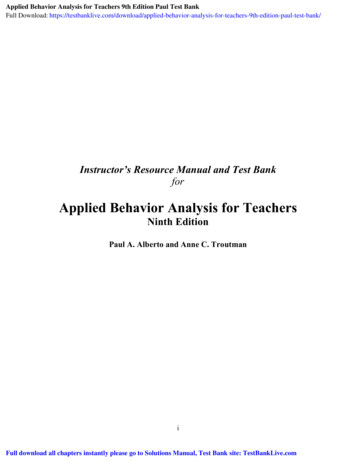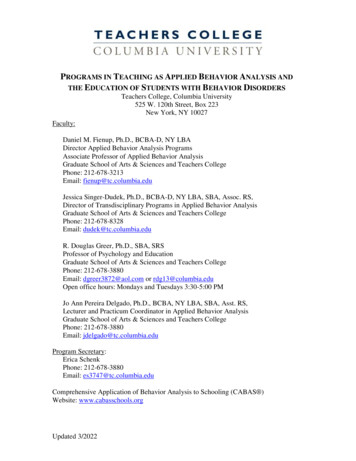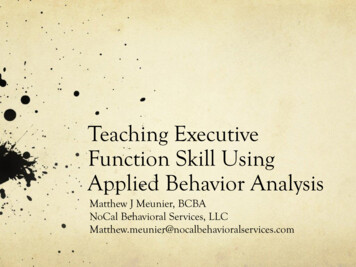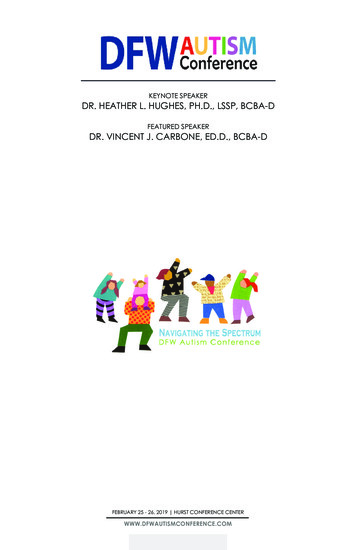
Transcription
Applied Behavior Analysis for Teachers 9th Edition Paul Test BankFull Download: Instructor’s Resource Manual and Test BankforApplied Behavior Analysis for TeachersNinth EditionPaul A. Alberto and Anne C. TroutmaniFull download all chapters instantly please go to Solutions Manual, Test Bank site: TestBankLive.com
PrefaceThe purpose of this instructor’s manual is to provide instructor’s who are using Alberto andTroutman’s Applied Behavior Analysis for Teachers, 9th Edition supplementary activities and resources fortheir lectures and assignments. Each of the chapters in this manual corresponds with the chapters inthe text. Each chapter in this manual contains the following: Chapter objectives: Contains instructional objectives pertaining to the chapter. Theseobjectives may be used in the development of a course syllabus. Chapter summary and outline: Contains a brief summary of the text chapter and a basiccontent outline In-class activities: These are suggested activities to include in class lectures. Correspondingslides and/or materials are also identified for their use in class. Homework assignments: Each chapter contains suggestions for corresponding homeworkassignments for students that supplement chapter content and lecture information. Theseassignments are designed as a supplement to class readings and lectures. Videos, Internet resources, Additional resources: These are teacher and/or studentresources that provide additional information or practice using concepts presented in thetext. PowerPoint Slides: PowerPoint slides are provided that highlight major concepts providedin each chapter. Handouts: Chapters also contain corresponding handouts that may be used for studenthomework assignments or review. Test Questions: Finally, each chapter in this manual concludes with a bank of testquestions that may be used for assessing student learning. Corresponding answers for eachtest may be found at the end of this manual.ii
Table of ContentsPageChapter 1 In class activities .Homework assignments and Resources .Handouts . Test Questions Chapter 2 In class activities Homework assignments and Resources .Test Questions Chapter 3 In class activities Homework assignments and Resources .Handouts . Test Questions Chapter 4 In class activities Homework assignments and Resources .Handouts . Test Questions Chapter 5 In class activities Homework assignments and Resources .Handouts Test Questions Chapter 6 In class activities Homework assignments and Resources .Handouts Test Questions Chapter 7 In class activities Homework assignments and Resources .Handouts Test Questions Chapter 8 In class activities Homework assignments and Resources .Handouts Test Questions 61626471727274758182838485
Chapter 9 In class activities Homework assignments and Resources .Test Questions Chapter 10 In class activities Homework assignments and Resources .Test Questions Chapter 11 In class activities Homework assignments and Resources .Test Questions Chapter 12 In class activities Homework assignments and Resources .Test Questions Chapter 13 . In class activities .Homework assignments .Test Questions Test Key 27127128130
5
Chapter 1Roots of Applied Behavior AnalysisChapter ObjectivesAfter reading this chapter, students will have an understanding of:1. The criteria required for identifying explanations of behavior that are useful and meaningful2. The historical development of applied behavior analysis3. The contributions of physicians, psychiatrists, scientists, and psychologists in the study of human behavior4. The impact different interpretations of human behavior have influenced practitioners and teachersChapter Summary and OutlineThis chapter discusses the requirements for meaningful and useful explanations of human behavior. It then describesseveral interpretations of human behavior that have influenced large numbers of practitioners, including teachers.The discussion includes tracing the historical development of a way of understanding and predicting humanbehavior called applied behavior analysis. The chapter concludes by providing several examples of applied behavioranalysis in action.I.The Usefulness of Explanations Why are explanations for behavior important? What requirements must be met in order to make an explanation useful? Inclusiveness Verifiability Predictive Utility ParsimonyII.Biophysical and Biochemical Explanations How have theorists searched for explanations for human behavior within the physical structure ofthe body? Biophysical Explanations (Genetic and Hereditary Effects) Biochemical Explanations (Brain Damage) Usefulness of Biophysical and Biochemical ExplanationsIII.Developmental Explanations What theories attempt to explain behavior based on fixed, innate developmental sequences? Psychoanalytic Theory A Stage Theory of Cognitive Development The Usefulness of Developmental TheoriesIV.Cognitive Explanation What theory attempts to explain behavior based on people’s perception of reality? Gestalt Psychology The Usefulness of Cognitive TheoryV.Behavioral Explanation What principles does the behaviorist apply to explain the development of both typical and atypicalhuman behavior? Positive Reinforcement Negative Reinforcement Punishment Extinction1
Antecedent Control Other Learning PrinciplesThe Task of the BehavioristThe Usefulness of the Behavioral ExplanationVI.Historical Development of Behaviorism Where did behaviorism originate? Historical Precedents Psychological Antecedents1. Respondent Conditioning Ivan Pavlov2. Associationism Edward Thorndike3. Behaviorism John Watson4. Operant Conditioning B.F. SkinnerVII.SummaryVIII.Discussion QuestionsIn Class ActivitiesActivityProvide an overview of the chapter.Define the terms inclusive, verifiable, predictiveutility, and parsimony.Provide an overview of the biophysical explanationof human behavior; introduce dominant andrecessive genetic inheritance.Describe how dominant genetic traits are passedfrom parents to their child.Describe how recessive genetic traits are passedfrom parents to their child.Provide an overview of biochemical explanation ofhuman behavior.Discuss the usefulness of the biophysical andbiochemical explanation of human behavior usingthe criteria inclusiveness, verifiability, predictiveutility, and parsimony.Introduce the second explanation of humanbehavior, developmental explanation. Brieflydiscuss the two developmental theories that addresshuman behavior.Show video on Sigmund Freud.Describe Jean Piaget’s Stage Theory of CognitiveDevelopment. Define assimilation, accommodation,and equilibration.ResourceSlide 1.2:Overview of Chapter 1Slide 1.3:Usefulness CriteriaSlide 1.4:Biophysical and Biochemical Explanation ofHuman BehaviorSlide 1.5:Dominant Genetic InheritanceSlide 1.6:Recessive Genetic InheritanceSlide 1.7:Biophysical and Biochemical Explanation ofHuman BehaviorSlide 1.8:Usefulness of Biophysical and BiochemicalExplanation of Human BehaviorSlide 1.9:Developmental Explanation of Human BehaviorBiography-Sigmund Freud (1997). VHS. A & EHome Video. 58 min.Slide 1.9:Developmental Explanation of Human Behavior2
ActivityShow video on Jean Piaget.Compare and contrast the Psychoanalytic Theoryand Stage Theory of Cognitive Development.Discuss the usefulness of the developmentalexplanation of human behavior using the criteria ofinclusiveness, verifiability, predictive utility, andparsimony.Define how Gestalt psychology has influencededucation. Ask students to summarize what usefulinformation they may gain from cognitiveinformation about their students.Discuss the usefulness of the cognitive explanationof human behavior using the criteria ofinclusiveness, verifiability, predictive utility, andparsimony.Identify the fourth explanation of human behavior,the behavioral explanation. Discuss the focus of abehavioral explanation of human behavior.Discuss and define the following important conceptsin the behavioral explanation: positivereinforcement, negative reinforcement, punishment,extinction, antecedent control, stimulus control,setting events, modeling, and shaping.Discuss the usefulness of the behavioral explanationof human behavior using the criteria ofinclusiveness, verifiability, predictive utility, andparsimony.Review the 4 theoretical explanations of humanbehavior using the criteria of inclusiveness,verifiability, predictive utility, and parsimony.Discuss the historical development of behaviorismfrom respondent conditioning through to operantconditioning.Show videos of B.F. SkinnerDefine the term applied behavior analysis.Discuss the 7 characteristics of research that isclassified as applied behavior analysis by Baer,Wolf, & Risely (1968).ResourcePiaget’s Developmental Theory: An Overview.(1989). VHS. San Luis Obispo, CA: DavidsonFilms Inc. 25 min.Slide 1.10:A Comparison of Freudian andPiagetian TheoriesHandout 1.1:A Comparison of Freudian andPiagetian TheoriesSlide 1.11:Usefulness of Developmental Explanation ofHuman BehaviorSlide 1.12:Cognitive Explanation of Human BehaviorSlide 1.13:Usefulness of Cognitive Explanation of HumanBehaviorSlide 1.14:Behavioral Explanations of Human Behavior:Slide 1.15 to 1.16:Important Concepts of BehavioralExplanationSlide 1.17:Usefulness of Behavioral Explanation of HumanBehaviorSlide 1.18:Usefulness of Explanations of Human BehaviorHandout 1.2:Usefulness of Explanations ofHuman BehaviorSlide 1.19 to 1.20:Historical Development ofBehaviorism B.F.Skinner: A Fresh Appraisal. (1999).VHS. San Luis Obispo, CA: DavidsonFilms Inc. 40 min. His Own Best Subject: A Visit to B.F.Skinner’s Basement. VHS. San LuisObispo, CA: Davidson Films Inc. 20 min.Slide 1.21:Applied Behavior AnalysisSlide 1.22:7 Characteristics of Research to Qualify asApplied Behavior Analysis3
Homework Assignments Have students observe a young child and identify the developmental stage at which the observed childis functioning according to Freud and Piaget Write a 1-2 paragraph example and explanation of the following sentence: “Learning occurs as a resultof the consequences of behavior.” Have students research instructional strategies teachers use to establish stimulus control. Strategiesinclude: antecedent cues, picture prompts, and auditory prompts. Have students review a study found in the Journal of Applied Behavior Analysis. Ask students toidentify the behavior targeted for change, the intervention used by the investigator(s), and whether afunctional relation between the two was established. Have students present their findings in class.Video Resources B.F. Skinner: A Fresh Appraisal (1999). VHS. San Luis Obispo, CA: Davidson Films Inc. 40 min. Biography-Sigmund Freud (1997). VHS. A & E Home Video. 58 min. His Own Best Subject: A Visit to B.F. Skinner’s Basement (2000). VHS. San Luis Obispo, CA: DavidsonFilms Inc. 20 min. Piaget’s Developmental Theory: An Overview (1989). VHS. San Luis Obispo, CA: Davidson Films Inc. 25min.Additional Text ResourcesBeilin, H., & Pufall, P. (1992). Piaget’s theory: Prospects and possibilities. Hillsdale, NJ: Lawrence ErlbaumAssociates.Morris, E.K., & Todd, J.T. (Eds) (1995). Modern perspectives on B.F. Skinner and Contemporary Behaviorism.Westport, CT: Greenwood Press.Nye, R. (1992). The legacy of B.F. Skinner: Concepts and perspectives, controversies and misunderstandings.Stamford, CT: Wadsworth.4
H 1.1HandoutsA Comparison of Freudian and Piagetian TheoriesFreud’s Psychoanalytic TheoryAGESTAGEBirth to 2 years Oral Stage: Gratification centeredaround the mouth2 to 4 yearsAnal Stage: Child derivesgratification from withholding andcontrolling feces. This correspondswith toilet training.4 to 6 yearsPhallic Stage: Gratificationcenters around genitalia. Childbecomes attached to parent of theopposite sex and develops hostilityto parent of the same sex.6 years topubertyLatency Stage: Child identifieswith the parent of the same sex andplay primarily with other childrenof the same sex in sex-stereotypedactivitiesGenital Stage: Child becomesinterested in members of theopposite sex.PubertyPiaget’s Theory of Cognitive DevelopmentAGESTAGESensorimotor Intelligence: Infant isBirth to 1 ½preoccupied with differentiatingyearshimself from the rest of the world andestablishing representations of objects1 ½ to 4 or 5Preoperational ThoughtRepresentational Thinking: The childyearsdevelops language, however is stillunable to take another person’s point ofview.5 to 7 yearsPreoperational Thought-IntuitionalThinking: Child begins to understandconservation, attends to more than oneaspect of an object at a time, andunderstands reversibility of someoperations.7 to 11 years Concrete Operations: Organizesperceptions and symbols; able toclassify along several dimensionssimultaneously; cannot solve abstractproblems.Formal Operations: Deals with12 years toabstractions, hypothetical situations,Adultand can think logically5
H 1.2Usefulness of Explanations of Human calPredictive odGoodDevelopmentalCognitiveBehavioral6
Chapter 1 Test QuestionsRoots of Applied Behavior AnalysisTrue-False Questions1-1. Developmental theories verify and prove that inappropriate and maladaptive behavior can be explained by afailure to reach or pass a particular stage.1-2. Certain genetic characteristics may increase the probability of certain behavioral characteristics.1-3. According to the psychoanalytic theory, most people fixate at a certain stage thus becoming overeaters,smokers, verbally abusive and/or anal-retentive.1-4. Gestalt psychology's emphasizes humans imposing structure on their environment and seeing relationshipsrather than individual objects or events as separate entities.1-5. John Watson first distinguished operant from respondent conditioning.1-6. A parsimonious explanation of behavior includes explanations distant fromobserved behavior and its relationship to the environment.1-7. The Gestalt psychology cognitive explanation for behavior meets the criterion of inclusiveness, predictiveutility, and parsimony for explaining behavior.1-8. Biophysical explanations of behavior include theories based on genetic or hereditary factors.1-9. Freud’s Psychoanalytic Theory provides a strong cognitive explanation of behavior.1-10. Developmental theories are difficult to verify and prove that the causes of behavior may be attributed topassage through a certain developmental stage.1-11. Gestalt psychology emphasizes that learning is a process of imposing structure on perceived information.1-12. Reflexive behaviors that are not under voluntary control are associated with operant conditioning.1-13. Behaviors that are voluntary in nature rather than reflexive are usually associated with operant conditioning.1-14. Applied behavior analysis may be defined as the process of applying behavioral principles to improvebehaviors while simultaneously evaluating whether noted changes may be attributed to the application ofthose principles.Multiple Choice Questions1-15. In explaining behavior, a useful theory must be:a. inclusive and justifiableb. inclusive, verifiable, and justifiablec. verifiable, exclusive, and predictabled. inclusive, verifiable, have predictive utility, and be parsimonious1-16. Information concerning a child's brain damage:a. can be useful in the teacher's selection of behavior management techniquesb. helps teachers determine who should be in school and who should notc. can cause teachers to have low expectations of students and give them excusesnot to teachd. none of the above7
1-17. A genuine scientific explanation must:a. be inclusive of all behaviorsb. predict one behavior to the exclusion of all other behaviorsc. a and bd. none of the above1-18. A relationship among events in which the rate of a behavior’s occurrence increases when some environmentalcondition is removed is:a. differential reinforcementb. reinforcementc. positive reinforcementd. negative reinforcement1-19. To the behaviorist, punishment occurs only when:a. the preceding behavior decreasesb. the preceding behavior increasesc. both a and bd. neither a or b1-20. The focus of the behavioral approach is:a. observing and predictingb. facilitating behavior changec. recording and verifying aberrant behaviorsd. all of the above1-21. Pairing stimuli so that an unconditioned stimulus elicits a response is known as all ofthe following EXCEPT:a. Pavlovianb. classicalc. respondent conditioningd. shaping1-22. “Jack can’t learn because he has Down syndrome” is an example of what explanation of behavior?a. biophysical explanationb. developmental explanationc. cognitive explanationd. behavioral explanation1-23. An antecedent stimulus is:a. an event occurring before the behavior is performedb. an event occurring after the behavior is performedc. a and bd. none of the above1-24. To qualify as a behavior, something must be:a. observableb. quantifiablec. a and bd. none of the above1-25. Behaviorists are LEAST concerned with the following:a. functional relationb. observable behaviorsc. present eventsd. past events8
1-26. For an explanation of behavior to be “verifiable” it musta. account for a substantial quantity of behaviorb. provide reliable answers about what people are likely to do under certain circumstancesc. provide the simplest explanationd. be testable1-27. Operant conditioning deals with behaviors.a. emotionalb. trainedc. reflexived. voluntary1-28. When a previously reinforced behavior is no longer reinforced and its rate ofoccurrence decreases, what behavioral principle is being used?a. Punishmentb. Positive Reinforcementc. Positive Punishmentd. Extinction1-29. When a student is given a pleasant consequence to a behavior and it results in an increase in the behavior’srate of occurrence, what behavioral principle is being used?a. Negative Reinforcementb. Positive Reinforcementc. Punishmentd. Stimulus control1-30. An event is described as if the rate of occurrence of a preceding behavior decreases.a. Negative Reinforcementb. Positive Reinforcementc. Shapingd. Punishment1-31. What is known as a “demonstration of behavior”?a. Modelingb. Shapingc. Positive Reinforcementd. Operant Conditioning1-32. The behavior principle that describes a relationship between behavior and anantecedent stimulus rather than behavior and its consequences are known as:a. Stimulus controlb. Respondent conditioningc. The Law of Effectd. Principle of Parsimony1-33. For an explanation of behavior to have predictive utility it musta. account for a substantial quantity of behaviorb. be testablec. provide the simplest explanationd. provide reliable answers about what people are likely to do under certain circumstances1-34. The Law of Effect is associated with what behavioral principle?a. Reinforcementb. Extinctionc. Punishmentd. Antecedent prompting9
1-35. For an explanation of behavior to be parsimonious, it musta. account for a substantial quantity of behaviorb. be testablec. provide the simplest explanationd. provide reliable answers about what people are likely to do under certain circumstances1-36. Who is associated or responsible for the use of the term “behaviorism?”a. Skinnerb. Watsonc. Darwind. Pavlov1-37 conditioning deals with behaviors that are voluntary rather thanreflexive.a. Operantb. Respondentc. Reflexived. Overactive1-38. What is the major purpose of applied behavior analysis?a. to provide a process of systematically applying specific principles to facilitate behavior changeb. to provide a systematic means of determining whether changes in behavior may be attributed to theapplication of behavioral principles.c. none of the aboved. both a and b1-39.Which of the following is NOT one of the criteria set forth by Baer, Wolf, and Risley (1968) as thequalifications for research to be considered applied behavior analysis:a. the behavior must be socially importantb. the behavior must be objectively definedc. a functional relation must be demonstratedd. must be an aberrant behavior1-40. Which of the following influenced the behaviorist movement?a. cognitivismb. functionalismc. constructivismd. none of the above1-41.John was scheduled to take a spelling test each Friday. His mother told him if he received 90% correct orbetter for three out of four spelling test he would get to buy a new video game. His mother was employingwhich of the following behavioral techniques?a. punishmentb. negative reinforcementc. shapingd. positive reinforcement1-42.Which of the following is attributed with the Stage Theory of Development?a. Jean Piagetb. Sigman Freudc. Ivan Pavlovd. B. F. Skinner10
1-43.Ms. Sims was having difficulty getting Tia to sit during morning circle. She decided that she wouldreinforce Tia’s attempts to sit during circle time. She began by reinforcing Tia when she was standing nextto her chair, then when she had one knee on her chair. She continued this process until Tia remained seatedduring morning circle time. Ms. Sims employed which the following behavioral techniques?a. modelingb. shapingc. positive reinforcementd. negative reinforcement1-44.Operant behaviors are voluntarily, whereas respondent behaviors are by stimuli.a. elicited, occasionedb. emitted, elicitedc. occasioned, emittedd. none of the above1-45.Circumstances which temporarily alter the power of a reinforcer are known as .a. modelsb. negative reinforcersc. setting eventsd. positive reinforcers1-46.Theorists who explain human behavior based on physical influences employ which of the followingexplanations?a. cognitiveb. biophysicalc. cognitived. behavioral1-47.Which of the following theorists is credited with classical conditioning?a. B.F. Skinnerb. Jean Piagetc. Ivan Pavlovd. none of the above1-48.is the process of using successive approximations to teach a new behavior or skill.a. stimulus controlb. shapingc. modelingd. generalizationShort Answer Questions1-49. What is meant by extinguishing a behavior?1-50. List three qualifications research must have in order to be considered Applied Behavior Analysis.1-51. What is meant by stimulus control?1-52. Define and give an example of modeling.Essay*1-53. Discuss how Skinner’s distinguishing of operant from respondent conditioning impacted the study of appliedbehavior analysis.11
*1-54. As a behaviorist working in a school of teachers who believe very strongly in developmental theory, howwould you convince them that a behavioral approach may be more appropriate for some of their students?* 1-55. Based on the criteria set forth by the usefulness explanation of human behavior (inclusiveness, verifiability,predictive utility, and parsimony) compare and contrast behaviorism with one of the following proposedexplanations of human behavior: biophysical, developmental, or cognitive.* 1-56. Define and differentiate between positive reinforcement, negative reinforcement, and punishment. Give anexample of each.*1-57 List and discuss the contributions put forth by three behaviorists and explain how their contributionsfurthered the field of behaviorism.12
Chapter 2Responsible Use of Applied Behavior Analysis ProceduresChapter ObjectivesFollowing completion of this chapter, students will:1. Understand why some resist the use of behavior change strategies2. Be familiar with how applied behavior analysis procedures are used ethically and responsibly3. Understand the components of accountabilityChapter Summary and OutlineThis chapter addresses many of the issues raised by those who practice applied behavior analysis. The authors beginby address the concerns raised in using procedures of applied behavior analysis and they examine some of thespecific criticisms raised against its use. In addition, ethical guidelines for using applied behavior analysisprocedures are discussed in detail.I.Concerns about applied behavior analysis Confusion with other procedures Reaction to controversial procedures Concerns about coercionII.Ethical use of applied behavior analysis procedures A therapeutic environment Services whose overriding goal is personal welfare Treatment by a competent behavior analyst Programs that teach functional skills Behavioral assessment and ongoing evaluation The most effective treatment procedures availableIII.Accountability How applied behavior analysis lends itself to accountabilityIV.SummaryV.Discussion Questions13
In Class ActivitiesActivityProvide an overview of the chapterExplain the difference between applied behavioranalysis and behavior modification procedures.Discuss reaction within the field of behavior analystand outside the field of applied behavior analysis tocontroversial procedures.Discuss the concerns about coercion and the way inwhich behavior analyst address these concerns.Discuss factors that must be considered indetermining whether a proposed intervention isethical.Describe the rights of potential recipients ofbehavior change treatments or interventions.Discuss the importance of accountability and theways in which behavior analyst addressaccountability.ResourceSlide 2.2:Chapter OverviewSlide 2.3:Examples of Applied Behavior AnalysisProcedures and Behavior ModificationProceduresSlide 2.4:Reactions to Controversial ProceduresSee text for full discussion.Slide 2.5:Concerns about CoercionSlide 2.6:Ethical Use of Applied Behavior AnalysisProceduresSlide 2.7-2.13:Individual RightsSlide 2.14:AccountabilityHomework Assignments Respond in a few paragraphs to the following: “What could happen if an applied behavior analysis procedure ismisused?” Locate and read the ethical guidelines for teachers and practitioners established by various professionalorganizations. Investigate and report on the controversy surrounding the use of behavior-change procedures.Additional ResourcesEthics Information www.apa.org/ethics/code.htmlEthical Principles of Psychologists and Code of Conduct www.apa.org/ethics/code.htmlCouncil for Exceptional Children Code of actice/Standards/CEC Code of Ethics for Educators of Persons with ExceptioanlitiesTask List and Knowledge, Skills, and Abilities Statements for Applied Behavior f%20files/TaskList-97%5B1%5D.pdf14
Chapter 2 Test QuestionsResponsible Use of Applied Behavior Analysis ProceduresTrue-False Questions2-1. “Humanists” often perceive any systematic effort to change behavior as coercive and inhumane.2-2. Behavioral approaches are less difficult to implement than most other procedures.2-3. The term “behavior modification” refers ONLY to procedures derived from the experimental analysis of humanbehavior.2-4. Research has shown that when positive reinforcement is used, intrinsic motivation is decreased.2-5. Behavior analysis has the power to remove the ability of the individual to choose alternative responses.2-6. It is unethical to exclude any student from the regular classroom regardless of its positive or negative effects.2-7. Suppressing behaviors such as whistling and laughing while in school is ethical if it helps to establish “law andorder” in the classroom.2-8. It is not ethical to assure parents that if a procedure is used, their child will no longer require placement in aspecial class.2-9. Informed consent is based on full understanding of all aspects of a planned program, including possible risks.2-10. It is unethical for teachers to arbitrarily decide what to teach students to do or stop doing.2-11. Applied Behavior Analysis is used to define the systematic methods employed for behavior change taught inthis course2-12. Consent that ensures voluntary participation in behavior change programs must be both voluntary andconsidered socially valid.2-13. It may be necessary to eliminate or reduce the rate of some student behaviors2-14. Voluntary consent implies publication of goals, procedures, and results so that they may be evaluated2-15. Applied Behavior Analysis refers only to procedures derived from the experimental analysis of humanbehavior.Multiple Choice Questions2-16. refers only to procedures derived from experimental analysis of human behavior.a. cognitive modificationb. behavior modificationc. systematic analysisd. all of the above2-17. Aversive or exclusionary procedures may create problems in ALL BUT ONE of the following ways:a. their misuse is common and often defined by the users as behavior modificationb. their use is always appropriate when administered by professionalsc. their use
Roots of Applied Behavior Analysis Chapter Objectives After reading this chapter, students will have an understanding of: 1. The criteria required for identifying explanations of behavior that are useful and meaningful 2. The historical development of applied behavior analysis 3.










